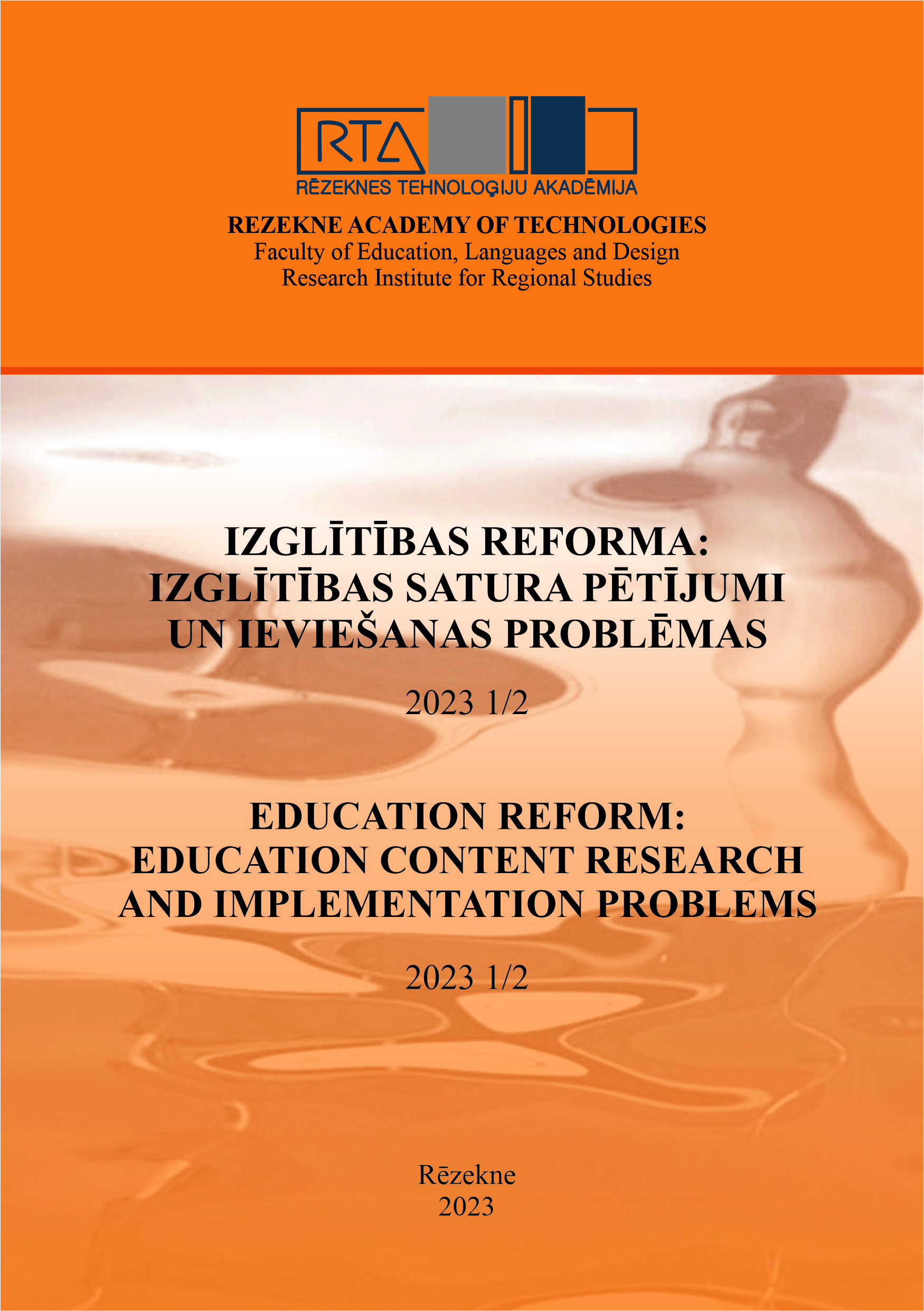EMOTIONS’ CATEGORIZATION FOR A BETTER EDUCATION
DOI:
https://doi.org/10.17770/er2023.1.7345Keywords:
Biological, categorization, emotions, interdisciplinary, psychological, quality of education, socialAbstract
Education can be enhanced via the application of the categorization method. Emotions’ categorization has been well addressed by the scientific community. However, research on emotions carried out in different disciplines enriches the existing knowledge with new findings and novel scientific contributions. The research aims at analysing scientific literature on emotions’ categories underpinning the elaboration of implications for educational practice. The method of categorization of the descriptive research is leveraged in this work for the characterisation of educational practice. Theoretical analysis allows concluding that emotions and education are linked. Emotions, being the innate part of an individual, drive the educational process. The educational process, built on the understanding of emotions as a cognition product, facilitates the development of individual’s emotions. The educational process is implemented in three phases, namely teaching, peer-learning, and learning. Each phase of the educational process has its own objective upon the development of education actors’ emotions. Organisation of only one or two phases of the educational process while omitting the other phase(s) leads to the imbalance of individual’s emotions. Quality of education is influenced by education actors’ emotions. Consequently, external and internal regulation of education actors’ emotions within the educational process might impact the quality of education
References
Ackerman, C.E. (2019). What are Positive and Negative Emotions and Do We Need Both? Available at https://positivepsychology.com/positive-negative-emotions/?utm_content= cmp-true
Ahrens, A., Zascerinska, J., Filimonova, D., & Bikova, A. (2023). How Emotions Are Developed: Insights From Vygotsky’S and Leontiev’s Works. Society. Integration. Education. Proceedings of the International Scientific Conference, Volume II, May 26th, 2023, 232-242. doi: https://doi.org/10.17770/sie2023vol2.7116
Ahrens, A., & Zaščerinska, J. (2014). Students’ Attitude to Interdisciplinary Research. Society, Integration, Education. Proceedings of the International Scientifical Conference, Volume I: Higher Education Institutions Pedagogy, School Pedagogy, Pre-School Pedagogy, 13-23. Rēzekne: Rēzeknes Augstskolas Izdevniecība.
Anaya-Durand, A., & Anaya-Huertas, C. (2010). Motivar para aprobar o para aprender, Estrategias de motivación del aprendizaje para los estudiantes. Tecnol. Ciencia. Educ. 25, 5–14.
Bachler, R, Segovia-Lagos, P, & Porras C. (2023). The role of emotions in educational processes: the conceptions of teacher educators. Front. Psychol. 14, 1145294. doi: 10.3389/fpsyg.2023.1145294.
Barnes, J. (2015). Comparing the performance of knowledge-based and machine-learning approaches for the detection of emotions in an English Text. Available at http://hdl.handle.net/10230/24828
Barrett, L. F. (2018). How emotions are made. Pan Books.
Bengtsson, M. (2016). How to plan and perform a qualitative study using content analysis. NursingPlus Open, Volume 2, 8-14. doi: https://doi.org/10.1016/j.npls.2016.01.001.
Burnard, P. (1995). Interpreting text: an alternative to some current forms of textual analysis in qualitative research. Social Sciences in Health, 1, 236-245.
Catanzaro, M. (1988). Using qualitative analytical techniques. N.F. Woods, M. Catanzaro (Eds.), Nursing: research theory and practice. The CV Mosby Company, St.Louis, pp. 437-456.
Celeghin, A., Diano, M., Bagnis A., Viola, M., & Tamietto, M. (2017) Basic Emotions in Human Neuroscience: Neuroimaging and Beyond. Front. Psychol. 8, 1432. doi: 10.3389/fpsyg.2017.01432.
Dos Santos, M. (2017). Walton's Quasi-Emotions Do Not Go Away, The Journal of Aesthetics and Art Criticism, Volume 75, Issue 3, 265–274. doi: https://doi.org/10.1111/jaac.12385
Graneheim, U.H. & Lundman, B. (2004). Qualitative content analysis in nursing research: concepts, procedures and measure to achieve trustworthiness. Nurse Education Today, 24, 105-112.
Gryzunov, O.V. & Gryzunov, V.V. (2022). Method for Managing Students’ Emotions Based on Morphological Analysis. Open education Educational Environment V. 26, № 3. doi: http://dx.doi.org/10.21686/1818-4243-2022-3-35-45.
Halton, C. (2021). Emotional Neutrality. Economics. Behavior Economics. Retrieved from: https://www.investopedia.com/terms/e/emotional-neutrality.asp
Jacob, E.K. (2004). Classification and Categorization: A Difference that Makes a Difference December 2004. Library Trends 52(3). Retrieved from: https://www.ideals.illinois.edu/items/1778
Jurist, E. (2019). Book Review. Journal of Theoretical and Philosophical Psychology. 2019, Vol. 39, No. 3, 193–198. doi: http://dx.doi.org/10.1037/teo0000098
Kennedy, T. (2021). Why Negative Emotions Aren’t That Bad (And How to Handle Them). Availbale at https://www.lifehack.org/articles/communication/how-handle-negative-emotions.html
Kim, H., Sefcik, J.S., & Bradway, C. (2017). Characteristics of Qualitative Descriptive Studies: A Systematic Review. Res Nurs Health. 2017 Feb;40(1):23-42. doi: 10.1002/nur.21768.
Kramiņa, I. (2000) Lingo – Didactic Theories Underlying Multi – Purpose Language Acquisition. University of Latvia.
Krippendorff, K. (2004). Content analysis: an introduction to its methodology. Sage Publications Inc., Thousand Oaks, California (2004).
McGarty, C., Mavor, K.I., & Skorich, D. (2015). Social Categorization. International Encyclopedia of the Social & Behavioral Sciences, Elsevier, 186–191, doi:10.1016/b978-0-08-097086-8.24091-9.
Morse, J.M. & Richards, L. (2002). Read me first for a user ׳s guide to qualitative methods. Sage
Publications Inc., Thousand Oaks, California (2002)
Patton, M.Q. (2002). Qualitative, research & evaluation methods. Sage publications Inc., Thousand Oaks, California.
Pyrev, E. A. (2019). Criticism of cognitive theories of the origin of emotions. Psychology in Education, vol. 1, no. 3, 258–265. doi: 10.33910/2686-9527-2019-1-3-258-265.
Polit, D.F., & Beck, C.T. (2006). Essentials of nursing research methods, appraisal, and utilization. Lippincott Williams & Wilkins, Philadelphia, PA.
Robbins, D. (2007). Vygotsky’s and Leontiev’s Non-classical Psychology Related to Second Language Acquisition. International Nordic-Baltic Region Conference of FIPLV Innovations in Language Teaching and Learning in the Multicultural Context, 15-16th June, 2007, Riga, Latvia 2007, 49-52.
Rolfe, G. (2006). Validity, trustworthiness and rigour: quality and the idea of qualitative research. Journal of Advanced Nursing, 53(2006), 304-310.
Siedlecki, S. L. (2020). Understanding Descriptive Research Designs and Methods. January 2020, Clinical nurse specialist CNS 34(1), 8-12. doi: 10.1097/NUR.0000000000000493.
Singh, A.R. & Singh, S.A. (2011). Brain-mind dyad, human experience, the consciousness tetrad and lattice of mental operations: and further, the need to integrate knowledge from diverse disciplines. Mens Sana Monogr. 2011 Jan; 9(1), 6-41. doi: 10.4103/0973-1229.77412.






